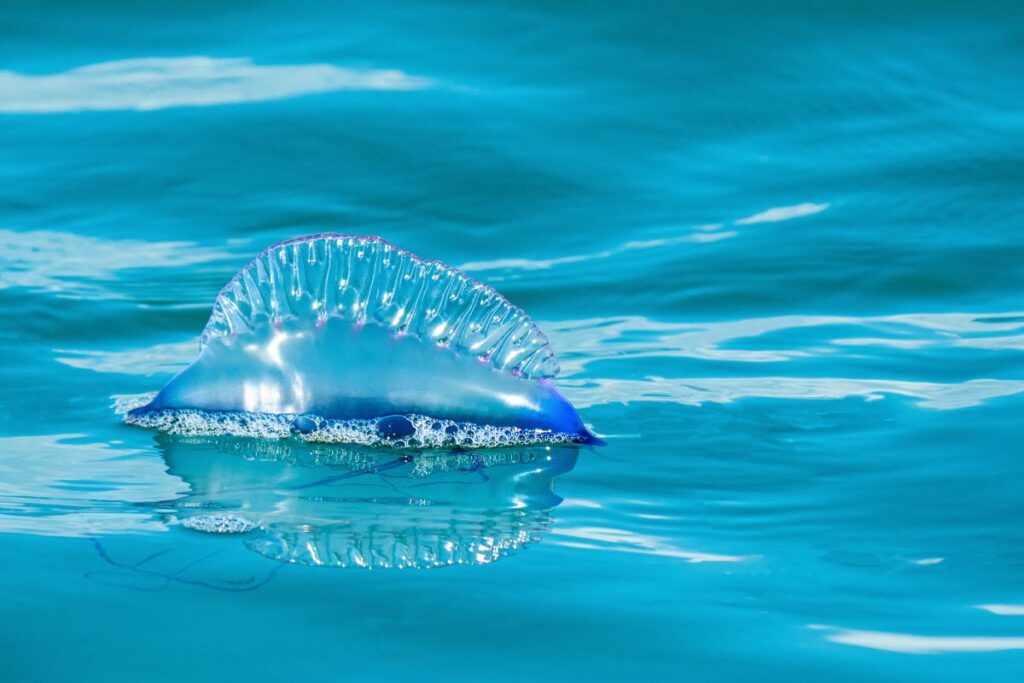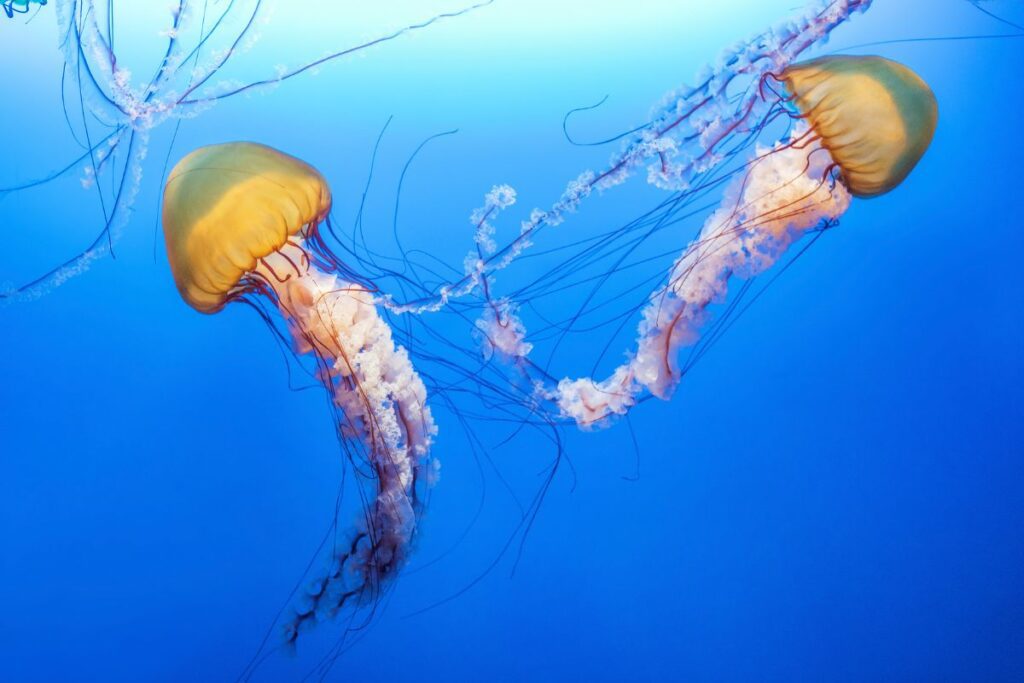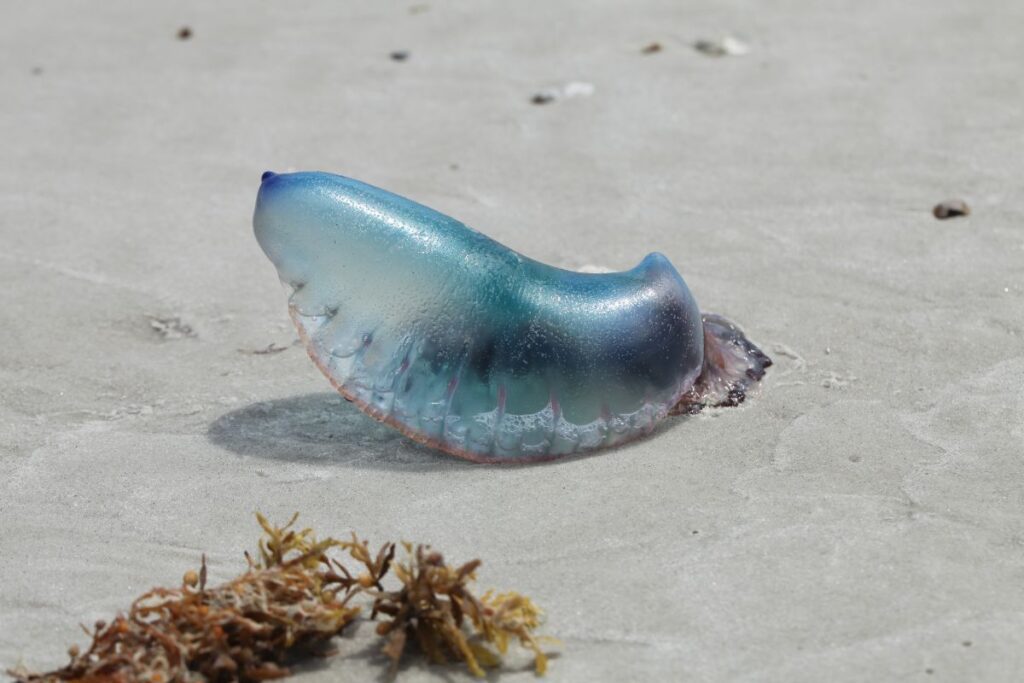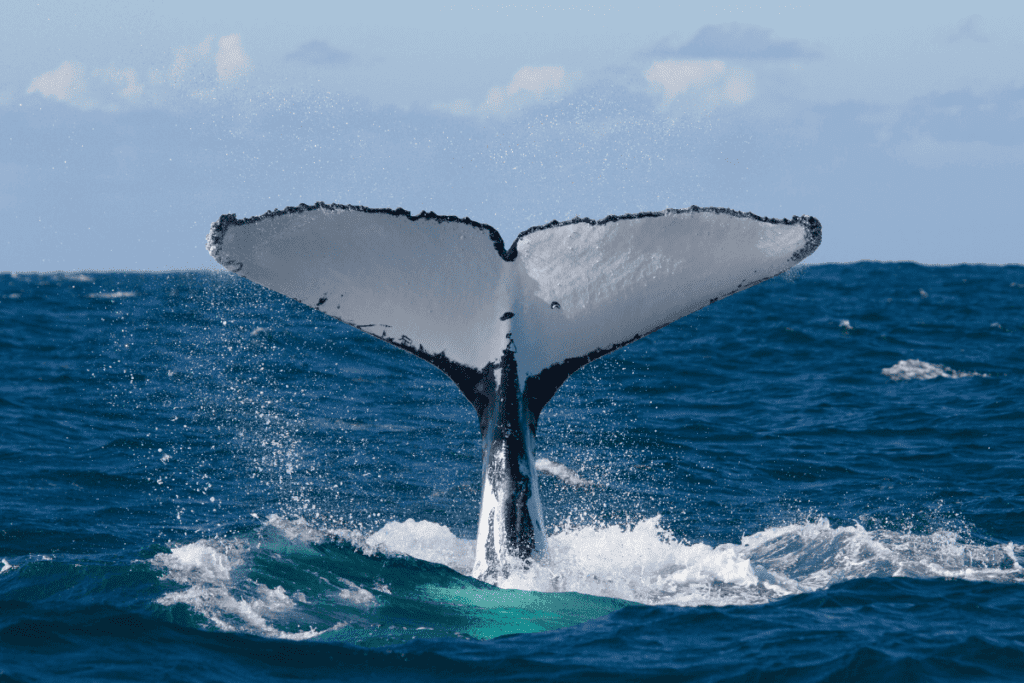When you think of mysterious, drifting sea creatures, jellyfish probably come to mind first. Translucent, tentacled, and oddly hypnotic. But what if we told you a lesser-known relative is floating in the deep that’s even stranger? Meet the siphonophore: a creature that looks like and acts like a jellyfish…but isn’t actually a jellyfish at all.
In this blog, we’ll dive into the weird and wonderful world of siphonophores, explore how they differ from their more famous cousins, and reveal why these colonial creatures might just blow your mind.
What Are Cnidarians?
Cnidarians are a group of animals that might seem simple at first glance, but they’re anything but ordinary. This group includes jellyfish, corals, sea anemones, and siphonophores. They are all united by one key feature: specialised stinging cells called cnidocytes. These tiny cells are used for hunting and defence, firing harpoon-like structures to catch prey or ward off threats.
Cnidarians are mostly soft-bodied and symmetrical, living in aquatic environments from shallow coral reefs to the deepest parts of the ocean. While they may all share a similar body plan, cnidarians come in a surprising variety of forms, including the solitary jellyfish and the bizarre colonial siphonophores.
Siphonophores: The Colonial Drifters
Siphonophores are truly fascinating creatures. They’re not a single animal, but colonies made up of individual organisms called zooids, each with a specialised function like feeding, movement, or reproduction, even though they’re all genetically identical. With around 175 known species, siphonophores come in a variety of forms, from long, string-like drifters to the more familiar and venomous Portuguese man o’ war (Physalia physalis).
They feed on small prey like crustaceans, copepods, and fish, using their tentacles to snare food as they drift through the water. Some species can grow to over 150 feet (46 meters) in length, even longer than a blue whale!

The Anatomy of a Jellyfish
Jellyfish might look like simple blobs, but their bodies are surprisingly well-designed for life in the water. They’re made up of a soft, bell-shaped body called the medusa, which pulses to help them swim. Their tentacles, which hang below the bell, are lined with stinging cells used to catch prey.
In the centre, they have a mouth that functions as an exit. Jellyfish don’t have a separate digestive or respiratory system like we do, and they don’t have brains or hearts, just a nerve net that helps them sense and respond to their surroundings.
Siphonophore vs Jellyfish: Tentacles, Bells, and Bioluminescence
Both jellyfish and siphonophores have long, trailing tentacles lined with stinging cells used to catch prey, but they use them in slightly different ways. Jellyfish usually have a central, umbrella-like bell that pulses to help them swim through the water, while siphonophores often rely on a specialised float or gas-filled structure to drift and steer. Some even have tiny, coordinated swimming zooids instead of a single bell.
When it comes to bioluminescence, both can glow beautifully in the dark ocean. Siphonophores, especially deep-sea species, often take it to the next level with dazzling light displays used to confuse predators or lure prey. Despite their similar look, their bodies are built and used in very different ways.

Behaviour and Function
Jellyfish may look delicate, but they’re surprisingly effective predators. They use their long tentacles, lined with stinging cells called cnidocytes, to capture and paralyse small prey like fish, plankton, and crustaceans. The tentacles then bring the food to the jellyfish’s mouth, which is located on the underside of its bell. To move, jellyfish pulse their bell-shaped bodies, pushing water behind them in a simple but graceful form of jet propulsion.
Their sting is their greatest weapon. While not all jellyfish are dangerous to humans, their stings can be painful or deadly to predators (and sometimes unlucky swimmers). Their transparent, gelatinous bodies also help them blend into their surroundings, making them harder to spot in the open ocean.
Where Do Jellyfish and Siphonophores Live?
Jellyfish are found in oceans all over the world, from shallow coastal waters to the open sea. Some species even thrive near the surface where sunlight reaches. On the other hand, siphonophores are more at home in the deep ocean, often drifting silently through the dark, cold waters of the midnight zone, thousands of meters below the surface.
Since siphonophores typically inhabit much deeper waters than most jellyfish, they are seldom encountered by humans, even though both species can be pelagic, or free-floating.
Life in the Deep: Why Siphonophores Thrive in the Abyss
The deep sea may seem like a harsh place to live, but it’s the perfect home for siphonophores. These colonial drifters are incredibly well-adapted to the dark, high-pressure environment of the deep ocean. Their delicate, gelatinous bodies are ideal for floating effortlessly through the water, and their bioluminescence helps them lure prey or confuse predators in the pitch-black surroundings.
Since food is scarce in the abyss, siphonophores use long, sticky tentacles to create massive curtain-like traps, efficiently capturing anything that swims by. With no need for speed and no competition for sunlight, they’ve evolved to thrive where few other creatures can survive.
Jellyfish
Diving deeper into the world of jellyfish reveals a remarkable diversity of species, each with unique appearances, habitats, and behaviours.
- Barrel jellyfish (Rhizostoma pulmo): One of the largest jellyfish found in European waters, with a dome-shaped bell that can grow up to 90 cm wide. It has a mild sting and is often seen in swarms.
- Compass jellyfish (Chrysaora hysoscella): Recognised by distinct brown, V-shaped markings radiating from the centre of the bell, like a compass. It has long tentacles and can deliver a moderate sting.
- Moon jellyfish (Aurelia aurita): A translucent species with four horseshoe-shaped gonads that are visible through the bell. They are common worldwide and generally harmless to humans.
- Lion’s mane jellyfish (Cyanea capillata): The largest known jellyfish species by bell diameter and tentacle length. It inhabits cold northern waters and has a painful sting.
- Mauve stinger jellyfish (Pelagia noctiluca): Small, purple-colored jellyfish that glow in the dark. It has a painful sting and is often responsible for jellyfish blooms in the Mediterranean.
- Blue Jellyfish (Cyanea lamarckii): Smaller than the lion’s mane jellyfish but closely related, the blue jellyfish comes in blue or yellow hues and is commonly found around the UK coastline. It delivers a mild to moderate sting.
- Stalked Jellyfish (Lucernaria and Haliclystus spp.): Unlike most jellyfish, these unusual benthic species live attached to rocks and seaweed via a stalk. They resemble tiny sea anemones and prefer cold, shallow waters, an exception to the typical free-swimming jellyfish body plan.
Siphonophores
The Portuguese man o’ war (Physalia physalis) is perhaps the most famous siphonophore and one of the most misunderstood. While it looks like a single jellyfish, it’s a colony of zooids functioning together as a single animal. It floats at the ocean surface using a gas-filled bladder that acts like a sail, catching the wind to move across the sea.
Below, its deadly tentacles, which can reach up to 30 metres, contain powerful stinging nematocysts used to paralyse fish and deter predators. Though visually stunning with its blue and purple hues, its sting can be extremely painful and even dangerous to humans.
Siphonophores range from shallow warm-water siphonophores to bizarre deep-sea siphonophores living thousands of metres below in the deeper waters of the ocean. These deep-sea organisms often have bioluminescent lures, glowing to attract prey or confuse predators in the darkness. Some species form enormous chains in the water column, with entire colonies of polyps (or zooids) organised into types of polyps such as digestive, reproductive, defensive, and tentacle-bearing zooids.

In exploring the fascinating differences between jellyfish and siphonophores, it’s clear that these ethereal marine invertebrates are far more complex than they first appear. Jellyfish are solitary animals; single organisms that pulse through the ocean using a bell, hunting with tentacles and drifting with currents.
Siphonophores, by contrast, are colonial animals composed of highly specialised zooids that each perform distinct roles in a community of organisms functioning as one. From digestive zooids to reproductive polyps, these colonies of zooids are among the most complicated organisms found in the deep ocean.
Despite their shared common ancestor, siphonophores vs jellyfish differ vastly in structure, behaviour, habitat, and life cycle. Their existence highlights the incredible adaptability and diversity of life in our oceans and underscores the importance of protecting this sustainable ocean environment for future generations.
FAQs
Are jellyfish and siphonophores the same thing?
No. Jellyfish are single organisms, while siphonophores are colonial organisms made up of many individual organisms (zooids) that work together like parts of a body with organs.
Do jellyfish and siphonophores sting?
Yes. Both use stinging cells (nematocysts) to capture prey and defend themselves. Some species, like the Portuguese man o’ war, can deliver painful and dangerous stings.
Can jellyfish or siphonophores swim?
Jellyfish swim by pulsing their bells. Some siphonophores use swimming zooids, while others rely on drifting with ocean currents and wind, especially those with air bladders.
Do jellyfish or siphonophores have brains or hearts?
No. Neither group has a brain or a heart. Jellyfish have a simple nerve net, and siphonophores coordinate through a shared system across their colonies of polyps.
What makes siphonophores so unique?
Their structure: siphonophores are made up of many types of zooids, each with specific functions like reproductive, defensive, or digestive polyps, making them one of the most structurally complex creatures in the ocean.


